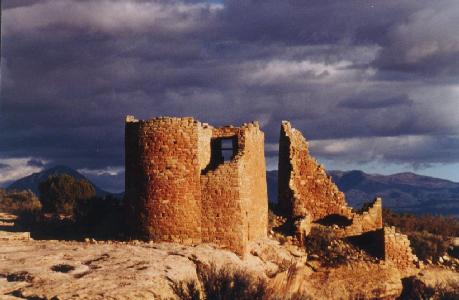 |
"Hovenweep Castle" appears to have had a function similar to that described by Cushing (From HAO education pages http://web.hao.ucar.edu/public/education/archeoslides/slide_5.html) |
Here is a description of how the Zuni in northern New Mexico identified the spring equinox:
"..one morning the Priest of the Sun declared aloud that the sun was returning. 'Our father has called and his father answers,' said the people to one another. The games ceased as if by magic; and the late profligate might now have been seen, early each morning, with hoe and spade in hand, wending his way out to the fields to prepare them for the planting time.
" Each morning, too, just at dawn, the Sun Priest, followed by the Master Priest of the Bow, went along the eastern trail to the ruined city of Ma-tsa-ki, by the river-side, where, awaited at a distance by his companion, he slowly approached a square open tower and seated himself just inside upon a rude, ancient stone chair, and before a pillar sculptured with the face of the sun, the sacred hand, the morning star, and the new moon.
 |
"Hovenweep Castle" appears to have had a function similar to that described by Cushing (From HAO education pages http://web.hao.ucar.edu/public/education/archeoslides/slide_5.html) |
"There he awaited with prayer and sacred song the rising of the sun. Not many such pilgrimages are made ere the 'Suns look at each other,' and the shadows of the solar monolith, the monument of Thunder Mountain, and the pillar of the gardens of Zuni, 'lie along the same train.' Then the priest blesses, thanks, and exhorts his father, while the warrior guardian responds as he cuts the last notch in his pine-wood calendar and both hasten back to call from the house-tops the glad tidings of the return of spring. Nor may the Sun Priest err in his watch of Time's flight; for many are the houses in Zuni with scores on their walls or ancient plates imbedded therein, while opposite a convenient window or small port-hole lets in the light of the rising sun, which shines but two mornings in the three hundred and sixty-five on the same place. Wonderfully reliable and ingenious are these rude systems of orientation, by which the religion, the labors, and even the pastimes of the Zuni are regulated." -- Frank Hamilton Cushing, 'My Adventures Among the Zuni," Century Illustrated Monthly Magazine, 1882-83.
Cushing stayed at the Zuni pueblo from 1879 to 1884. He learned the Zuni language and won acceptance in the tribe, eventually becoming a member of the tribal council and the Priesthood of the Bow. The events he reports occurred in the late 19th century, but they must have been typical of events in many agrarian societies with modest technical means to set the time for planting.